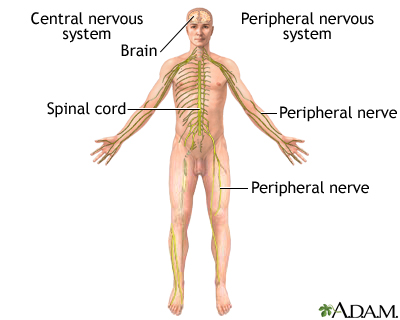Pregnancy SmartSiteTM
Polyneuropathy - sensorimotor DefinitionSensorimotor polyneuropathy is a condition that causes a decreased ability to move and feel (sensation) because of nerve damage. CausesNeuropathy means a disease of, or damage to nerves. When it occurs outside of the central nervous system (CNS), that is, the brain and spinal cord, it is called a peripheral neuropathy. Mononeuropathy means one nerve is involved. Polyneuropathy means that many nerves in different parts of the body are involved. Neuropathy can affect nerves that provide feeling (sensory neuropathy) or cause movement (motor neuropathy). It can also affect both, in which case it is called a sensorimotor neuropathy. Sensorimotor polyneuropathy is a bodywide (systemic) process that damages nerve cells, nerve fibers (axons), and nerve coverings (myelin sheath). Damage to the covering of the nerve cell causes nerve signals to slow or stop. Damage to the nerve fiber or entire nerve cell can make the nerve stop working. Some neuropathies develop over years, while others can start and get severe within hours to days. Nerve damage can be caused by:
Some diseases lead to polyneuropathy that is mainly sensory or mainly motor. Possible causes of sensorimotor polyneuropathy include:
SymptomsSymptoms may include any of the following:
Symptoms may develop quickly (as in Guillain-Barré syndrome) or slowly over weeks to years. Symptoms usually occur on both sides of the body. Most often, they start at the ends of the toes first. Exams and TestsThe health care provider will examine you and ask about your symptoms. An exam may show:
Tests may include:
TreatmentGoals of treatment include:
Depending on the cause, treatment may include:
PROMOTING SELF-CARE AND INDEPENDENCE
CONTROL OF SYMPTOMS Safety is important for people with neuropathy. Lack of muscle control and decreased sensation can increase the risk of falls or other injuries. If you have movement difficulties, these measures can help keep you safe:
Other tips include:
Medicines used to treat the symptoms of this condition:
Other treatments may be directed against your immune system to stop an autoimmune attack:
Use pain medicine only when necessary. Keeping your body in the proper position or keeping bed linens off a tender body part may help control pain. Support GroupsThese groups can provide more information about neuropathy.
Outlook (Prognosis)In some cases, you can fully recover from peripheral neuropathy if your provider can find the cause and successfully treat it, and if the damage does not affect the entire nerve cell. The amount of disability varies. Some people have no disability. Others have partial or complete loss of movement, function, or feeling. Nerve pain may be uncomfortable and may last for a long time. In some cases, sensorimotor polyneuropathy causes severe, life-threatening symptoms. Possible ComplicationsProblems that may result include:
When to Contact a Medical ProfessionalContact your provider if you have loss of movement or feeling in a part of your body. Early diagnosis and treatment increase the chance of controlling the symptoms. ReferencesCraig A. Neuropathies. In: Cifu DX, ed. Braddom's Physical Medicine & Rehabilitation. 6th ed. Philadelphia, PA: Elsevier; 2020: chap 41. Endrizzi SA, Rathmell JP, Hurley RW. Painful peripheral neuropathies. In: Benzon HT, Raja SN, Liu SS, Fishman SM, Cohen SP, eds. Essentials of Pain Medicine. 4th ed. Philadelphia, PA: Elsevier; 2018:chap 32. Katirji B. Disorders of peripheral nerves. In: Jankovic J, Mazziotta JC, Pomeroy SL, Newman NJ, eds. Bradley and Daroff's Neurology in Clinical Practice. 8th ed. Philadelphia, PA: Elsevier; 2022:chap 106. Ralph JW, Aminoff MJ. Neuromuscular complications of general medical disorders. In: Aminoff MJ, Josephson SA, eds. Aminoff's Neurology and General Medicine. 6th ed. Cambridge, MA: Elsevier; 2021:chap 60. Smith AG, Shy ME. Peripheral neuropathies. In: Goldman L, Cooney KA, eds. Goldman-Cecil Medicine. 27th ed. Philadelphia, PA: Elsevier; 2024:chap 388. | ||
| ||
Review Date: 12/31/2023 Reviewed By: Joseph V. Campellone, MD, Department of Neurology, Cooper Medical School at Rowan University, Camden, NJ. Review provided by VeriMed Healthcare Network. Also reviewed by David C. Dugdale, MD, Medical Director, Brenda Conaway, Editorial Director, and the A.D.A.M. Editorial team. View References The information provided herein should not be used during any medical emergency or for the diagnosis or treatment of any medical condition. A licensed medical professional should be consulted for diagnosis and treatment of any and all medical conditions. Links to other sites are provided for information only -- they do not constitute endorsements of those other sites. No warranty of any kind, either expressed or implied, is made as to the accuracy, reliability, timeliness, or correctness of any translations made by a third-party service of the information provided herein into any other language. © 1997- A.D.A.M., a business unit of Ebix, Inc. Any duplication or distribution of the information contained herein is strictly prohibited. | ||


 Central nervous sy...
Central nervous sy... Nervous system
Nervous system
